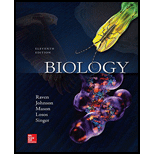
Concept explainers
Source-sink metapopulations are distinct from other types of metapopulations because
a. exchange of individuals only occurs in the former.
b.
c. populations never go extinct in the former.
d. all populations eventually go extinct in the former.
Introduction:
When the network of different populations exchanges its individuals, it is known as metapopulation. This happens because of the distribution of suitable and unsuitable habitat. If there is difference in the habitats of long term populations which affect its growth and decline is known as source-sink metapopulation.
Answer to Problem 1U
Correct answer:
The decline in the population is also considered in the source-sink metapopulation. Therefore, option b. is correct.
Explanation of Solution
Reason for the correct statement:
In source-sink population, there is continuous sending of dispersers from better areas that bolster the population in the areas that are poorer. The better areas or habitats act as the source and the poorer areas or habitats act as sink. If there is no continuous shifting of individuals, then the sink population increases and shows a negative growth and may lead to extinction.
Option b. is given as“populations with negative growth rates are a part of the former”.
As, “Source-sink metapopulations are distinct from the types of metapopulations because populations with negative growth rates are a part of the former”, is the right answer.
Hence, the option b. is correct.
Reasons for the incorrect statements:
Option a. is given as “exchange of individuals only occurs in the former”.
The exchange of individuals occurs in both metapopulations as well as in the source-sink populations. So, it is a wrong answer.
Option c. is given as “populations never go extinct in the former”.
In sink-source metapopulations, if the continuous replenishment is absent, then the poor habitat show negative growth rates that may lead to the extinction of species. So, it is a wrong answer.
Option d. is given as “all populations eventually go extinct in the former”.
Not all the populations show negative growth; only a part of population of poorer habitat show negative growth and extinct. So, it is a wrong answer.
Hence, options a., c., and d. are incorrect.
The metapopulations involves the migration of individuals from one group to another group in a population. In source-sink population, one of the populations with poor habitat may show negative growth.
Want to see more full solutions like this?
Chapter 55 Solutions
Biology
- Which of the following is not a DNA binding protein? 1. the lac repressor protein 2. the catabolite activated protein 3. the trp repressor protein 4. the flowering locus C protein 5. the flowering locus D protein 6. GAL4 7. all of the above are DNA binding proteinsarrow_forwardWhat symbolic and cultural behaviors are evident in the archaeological record and associated with Neandertals and anatomically modern humans in Europe beginning around 35,000 yBP (during the Upper Paleolithic)?arrow_forwardDescribe three cranial and postcranial features of Neanderthals skeletons that are likely adaptation to the cold climates of Upper Pleistocene Europe and explain how they are adaptations to a cold climate.arrow_forward
- Biology Questionarrow_forward✓ Details Draw a protein that is embedded in a membrane (a transmembrane protein), label the lipid bilayer and the protein. Identify the areas of the lipid bilayer that are hydrophobic and hydrophilic. Draw a membrane with two transporters: a proton pump transporter that uses ATP to generate a proton gradient, and a second transporter that moves glucose by secondary active transport (cartoon-like is ok). It will be important to show protons moving in the correct direction, and that the transporter that is powered by secondary active transport is logically related to the proton pump.arrow_forwarddrawing chemical structure of ATP. please draw in and label whats asked. Thank you.arrow_forward
- Outline the negative feedback loop that allows us to maintain a healthy water concentration in our blood. You may use diagram if you wisharrow_forwardGive examples of fat soluble and non-fat soluble hormonesarrow_forwardJust click view full document and register so you can see the whole document. how do i access this. following from the previous question; https://www.bartleby.com/questions-and-answers/hi-hi-with-this-unit-assessment-psy4406-tp4-report-assessment-material-case-stydu-ms-alecia-moore.-o/5e09906a-5101-4297-a8f7-49449b0bb5a7. on Google this image comes up and i have signed/ payed for the service and unable to access the full document. are you able to copy and past to this response. please see the screenshot from google page. unfortunality its not allowing me attch the image can you please show me the mathmetic calculation/ workout for the reult sectionarrow_forward
 Biology (MindTap Course List)BiologyISBN:9781337392938Author:Eldra Solomon, Charles Martin, Diana W. Martin, Linda R. BergPublisher:Cengage Learning
Biology (MindTap Course List)BiologyISBN:9781337392938Author:Eldra Solomon, Charles Martin, Diana W. Martin, Linda R. BergPublisher:Cengage Learning Concepts of BiologyBiologyISBN:9781938168116Author:Samantha Fowler, Rebecca Roush, James WisePublisher:OpenStax College
Concepts of BiologyBiologyISBN:9781938168116Author:Samantha Fowler, Rebecca Roush, James WisePublisher:OpenStax College
 Human Biology (MindTap Course List)BiologyISBN:9781305112100Author:Cecie Starr, Beverly McMillanPublisher:Cengage Learning
Human Biology (MindTap Course List)BiologyISBN:9781305112100Author:Cecie Starr, Beverly McMillanPublisher:Cengage Learning Biology: The Dynamic Science (MindTap Course List)BiologyISBN:9781305389892Author:Peter J. Russell, Paul E. Hertz, Beverly McMillanPublisher:Cengage Learning
Biology: The Dynamic Science (MindTap Course List)BiologyISBN:9781305389892Author:Peter J. Russell, Paul E. Hertz, Beverly McMillanPublisher:Cengage Learning





